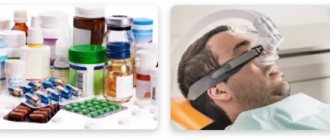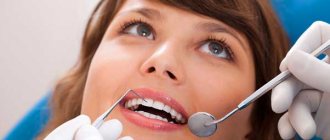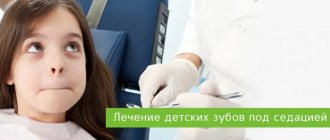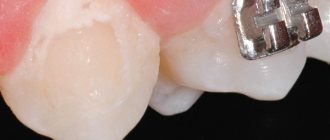Stages of sedation Types When treating children Possible complications Indications Preparation for the procedure Contraindications Anesthesia Alternatives
There are few people in the world who are not afraid of a visit to the dentist. Against the backdrop of such a widespread phobia, calls are increasingly being made to undergo treatment under sedation, without pain. What is it and is this method as safe as they say?
Dental treatment under anesthesia in adults is carried out in rare cases, more often in hospitals. But sedation is more common. This method causes inhibition of the nervous system to reduce panic and stress during the procedure. There is contact with the doctor, the patient is able to respond to stimuli. With this method of anesthesia, the patient breathes on his own, all his reflexes are preserved. This is the main difference between sedation and anesthesia, in which the degree of inhibition reaches such a level that consciousness turns off, reflexes are not preserved, and the patient does not respond to physical and verbal stimuli. The main purpose of anesthesia is to put the patient into a state in which he does not feel anything.
The main goal of sedation is not to harm the patient’s health, so before the procedure it is necessary to do a full examination of the body and obtain a conclusion from a general practitioner and anesthesiologist.
Sedation will help:
- relax during an unpleasant or painful procedure;
- perform local anesthesia without tension and fear;
- provide comfort, moral and physical;
- create a calm environment for the dentist to work.
Stages of sedation
- Easy
. The patient is in a state of relaxation, but is awake and makes contact with the doctor. Although his reactions and coordination are slightly reduced. This type of sedation is also called superficial. - Average
. A state of consciousness in which patients respond to tactile stimuli, all functions are preserved, reflexes work, and there is interaction with the doctor. - Deep
. The patient reacts only to strong stimulation; the patient does not respond to a call, but the cardiovascular system works normally. Breathing may become irregular
The next stage is complete anesthesia. With it, there is no reaction even to strong painful stimuli. Respiratory support is often needed.
Types of sedation in dentistry
There are quite a few ways to administer relaxing drugs, but only a few of them are used in dental clinics:
- Inhalation
. The most common mind control technique. The advantages of dental treatment under sedation through inhalation: quick effect, the process is easy to control, consciousness is restored in a very short period of time. The most common use is nitrous oxide. It has a relaxing effect, reduces motor activity and has some analgesic properties. Subject to the rules of supply and percentage of gases, there are practically no side effects. - Injection
. The drug is administered once, as an injection or gradually, through an intravenous infusion system. The most well-known drugs are profopol and medazolam. Their hypnotic effect allows dental treatment to be performed while you sleep, while maintaining basic reflexes and spontaneous breathing. Recently, dexmedetomidine has been increasingly used because it does not lower blood pressure. - Oral medication
. If the patient is afraid of the needle, but calmly takes the pills, they can be used. - Intranasal dispersion
. An anesthetic is sprayed into the nasal passages. So the drug, through the taste buds, immediately enters the brain. Quick effect, bioavailability, central action and ease of use make sprays very popular.
Types of local anesthetics
All medications used by dentists are based on substances from one of two chemical groups:
- Esters: novocaine, tetracaine (dicaine), benzocaine (anesthesin). These compounds are not very stable and are quickly destroyed in body tissues, so their effect is short-lived.
- Amides: lidocaine, trimecaine, melivacaine, bupivacaine, ultracaine (articaine). They are stable, penetrate deep into tissues and, accordingly, provide more effective pain relief [1].
Sedation in pediatric dentistry
Up to 50% of children
[1] hide dental problems due to fear of treatment. This affects their quality of life and oral health both in childhood and when they grow up. Therefore, the use of mind control measures when providing dental care to children is justified, subject to strict adherence to rules and regulations. Most often, medicated sleep during dental treatment in children is achieved using nitrous oxide, but there are studies that have confirmed the effectiveness of the use of other medications. It is worth remembering that sedation should be used only when no other method of dental treatment for a child does not work. This will help avoid harmful consequences.
Consequences of sedation in dentistry
Specific problems with the use of mind control drugs depend on the route of administration and the mechanism of action of the drugs.
At the beginning of the procedure, you may experience increased activity, physical restlessness, talkativeness, and increased sociability.
A common symptom is an obsessive cough. This problem can be stopped by reducing the dose of the drug. Complications after sedation can appear both immediately and in a delayed period.
Possible short-term complications
- Breathing disorders (slow breathing, lack of oxygen);
- problems with hemodynamics (drop in blood pressure, irregular heart rhythm);
- depression of the central nervous system;
- intestinal dysfunction, vomiting.
Delayed symptoms
- Development of psychoses;
- hallucinatory syndrome;
- paralysis.
Is sedation dangerous? No, if it is carried out by an experienced doctor who has undergone special training, and the clinic is equipped with everything necessary to eliminate the consequences. But this is not a magic pill that can be prescribed to everyone without thinking about the consequences.
At-risk groups
Some categories of patients are hypersensitive to local anesthesia. The table lists the main risk groups and possible solutions for them.
| Risk group | Recommendations |
| Pregnancy |
|
| Elderly age |
|
| Anorexia nervosa |
|
| Bronchial asthma |
|
| Chronical bronchitis |
|
| Hepatitis |
|
| Hypertension (high blood pressure) |
|
| Heart rhythm disturbances |
|
| Cardiac ischemia |
|
| Heart failure |
|
| Kidney failure |
|
| Porphyria |
|
| Cirrhosis of the liver |
|
| Glaucoma |
|
| Emphysema and chronic obstructive pulmonary disease |
|
| Peptic ulcer |
|
Indications
Dental sedation is indicated in a state of increased excitability, fear of treatment, but is not limited to this. This method must be used if there is:
- strongly expressed gag reflex;
- mental problems that exclude interaction with the patient;
- traumatic manipulations.
Like any medical intervention, mind control using medicinal methods requires careful preparation. The decision is made by the doctor taking into account all the data.
Contraindications to sedation
Like any medical procedure, depression of consciousness has contraindications. There are very few of them. The only absolute contraindication is myasthenia gravis (muscle weakness). The remaining states are relative. These are drug or alcohol intoxication, hypotension, a full stomach, a disorder of consciousness that prevents interaction with the patient, pregnancy, a condition after an acute heart attack/stroke. An opinion on the possibility of carrying out this procedure can only be issued by a general practitioner and an anesthesiologist.
The choice of method may also be limited. Thus, inhalation methods are contraindicated for sinusitis and other diseases of the upper respiratory tract. The doctor must know about all diseases in order to select the appropriate drug for a particular one in order to use medicinal sleep in dental treatment without consequences. That is why it is important to treat teeth in a clinic with modern technical facilities. Typically, such dentists employ experienced anesthesiologists and have equipment for first aid.
Minimizing risks
If you are at risk, tell your dentist about it at the very beginning of your appointment. It is also very important to report if you have ever had an allergic reaction to anesthesia. Write down exactly what drug triggered it, and be sure to notify your doctors.
Dentists, in turn, take all precautions to minimize the danger:
- carefully study the anamnesis;
- give preference to drugs with a minimum concentration of vasoconstrictors;
- an aspiration test is carried out: after inserting the needle, the medium in which its tip is located is sucked in to prevent it from entering a blood vessel;
- inject the anesthetic slowly, observing the patient’s reaction;
- have an emergency medical kit for resuscitation on hand;
- sedatives are used (sedative premedication), which relax the patient and allow the dose of anesthetic to be reduced [3, 4].
Already at the preliminary consultation, you can understand how psychologically difficult it will be for the patient to undergo the operation.
If a patient immediately says that he needs more anesthesia because it “doesn’t work” on him, this is the first sign that he is very afraid of surgery (in fact, anesthesia affects everyone the same). This means that sedative premedication may be needed. Ashurko I. P., Ph.D., Associate Professor, Sechenov University [4]
During traumatic manipulations in the oral cavity - for example, implantation or tooth extraction - you cannot do without anesthesia. However, modern dental equipment can solve many problems without causing pain. Often, treatment of caries or installation of a filling can be carried out without local anesthesia. Try to avoid painkillers during simple interventions to ensure you avoid any unpleasant consequences associated with them.
List of sources:
- Sharapov O. Yu., Borozda I. V. Local anesthesia in dentistry: a textbook. Blagoveshchensk: Federal State Budgetary Educational Institution of Higher Education of the Amur State Medical Academy of the Ministry of Health of Russia, 2022. // URL: https://www.amursma.ru/upload/iblock/bff/Uchebnoe_posobie_Mestnaya_anesteziya_v_stomatologii_.pdf (access date 08/28/2020).
- Siberian Medical Portal // URL: https://www.sibmedport.ru/article/5529-chem-opasna-mestnaja-anestezija/ (date accessed 08/28/2020).
- Baart J. A., Brand X. S. Local anesthesia in dentistry. M.: Med. lit., 2010. // URL: https://dental-ss.org.ua/load/kniga_stomatologia/khirurgicheskaja/baart_mestnaja_anestezija_stomatologii/10-1-0-855 (access date 08/28/2020).
- Our teeth, gums and bone tissue through the eyes of a dental surgeon, interview with Ashurko I.P., Ph.D., Associate Professor // URL: https://www.unident.ru/publications/Osobyj-vzglyad-13502.phtml (date of access: 09/02/2020).
Anesthesia in dentistry
There are medical terms that in ordinary life lose their meaning or acquire additional meaning. One example is the expression “to treat teeth under anesthesia.” In 99% of cases, this expression refers to ordinary sedation. Due to a common mistake, even dentists sometimes use the term “anesthesia,” although this means depression of consciousness with preservation of reflexes and responses.
Dental treatment under general anesthesia is performed extremely rarely. Its administration requires special equipment and conditions. Usually, this happens in a hospital, by an oral and maxillofacial surgeon, as a procedure accompanying the operation. During manipulation, constant monitoring of blood pressure, heart rate, respiratory rate, and blood oxygen saturation is required.
General anesthesia during dental treatment means a complete shutdown of consciousness, including protective reflexes, which can be dangerous. The patient should not choose the method of pain relief himself; this can only be done by a doctor after a certain examination.
Dental treatment under general anesthesia
General anesthesia in dentistry
When performing an operation, a team consisting of an anesthesiologist-resuscitator, a dentist, a nurse anesthetist, and a dental assistant must be present in the operating room.
First, the patient is fitted with cardiac monitor sensors, a cuff is put on his arm (to continuously measure pressure), and a special sensor is put on his finger to determine saturation (oxygen saturation in the blood), and only after that the anesthetist punctures the vein and a gradual introduction into shallow or deep sleep occurs.
General anesthesia , as well as dental treatment, are carried out under the strict supervision of an anesthesiologist throughout the operation.








